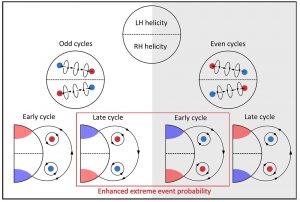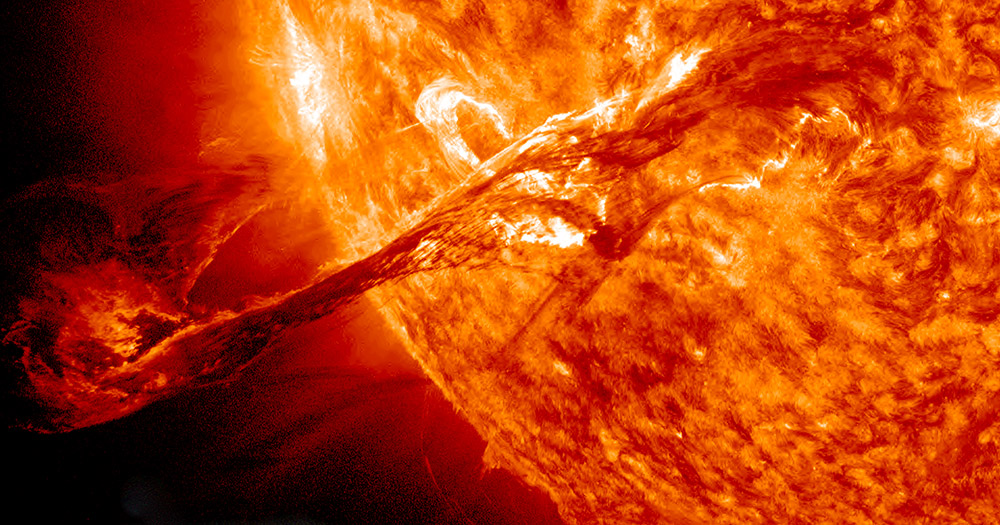Increased risk: When severe solar storms occur in a solar cycle do not rely solely on maximum sun. Instead, cycle length and order also play a role: In odd-numbered cycles, strong solar storms occur later than even-numbered cycles, a comparative study revealed. The reason for this may be the changing polarity of the solar magnetic field. This is also important for upcoming lunar missions.
Our Sun’s activity goes through regular cycles: approximately every 11 years, solar storms, ray bursts, and sunspots peak and then subside again. All in Solar maximum The solar magnetic field is also reflected. This change is likely to be driven by the major players Circulating flows Inside the sun. When powerful solar storms hit Earth, they can cause significant damage to satellites, cause blackouts and paralyze communications.
But the consequences would be more serious if astronauts were hit by one of these bursts of rays and streams of high-energy particles outside of Earth’s protective magnetic field – for example during a trip to the moon. In 1972, the astronauts on the Apollo 16 and 17 missions were lucky enough to have one One of the strongest solar storms From the space age it happened exactly between their flights.
What is the size of the risks of the upcoming lunar trips?
And now a manned mission to the moon is on the horizon again, including building one Lunar space station And the US mission Artemis. It should land on Earth’s satellite since 2024 astronauts. This raises the question of how high the risk of a strong solar storm will be in the current solar cycle and when the phase of strongest solar activity can be expected. It seems clear that the overall risk of solar storms increases around the sun’s maximum, but the strongest and thus most dangerous events to date are largely unpredictable.
“Because the timing of the most extreme solar storms was previously thought to be largely random, it was also thought that it was difficult to plan around precisely,” explains Matthew Owens of the University of Reading. On the basis of 150 years of data on solar activity, he and his team have now re-examined whether there are time patterns that could make forecasting easier.
The longer the cycle, the more massive storms
The result: Contrary to previously thought, even severe solar storms follow predictable patterns, at least to a certain extent. Accordingly, not only do they occur more frequently around the sun’s extremes, but the risk of such events is also higher in longer solar cycles, the researchers report. Because solar cycles last an average of about eleven years, but their individual lengths range from nine to 14 years.
But this may mean that a file Current solar cycle 25 It brings with it several particularly strong solar storms. Because it follows a very short previous cycle and will likely belong to longer cycles, as scientists did at the end of 2020 Predict the climate to have. So the next maximum solar energy could be particularly powerful.

In individual courses the peak comes later
But that’s not all: to their surprise, scientists discovered another time pattern in strong solar storms. According to this, these massive outbreaks of solar energy occur early in even numbered cycles, but later in unequal solar cycles. For the current cycle, this could mean that the greatest risk is after 2025. Owens and his team said: “All of our scenarios show us peak activity occurring somewhat late in the active phase of the current solar cycle – around the beginning of 2026.”
The researchers attribute this to the direction of the solar magnetic field: thus the probability of a severe storm hitting Earth always increases when the solar and terrestrial magnetic fields have the same direction. This is the case with solar cycles even before a polarity reversal at the solar maximum, in unequal cycles, but only afterwards.
High risk of planned lunar missions
What does this mean for space plans for the next few years? After all, after the United States of America, China and Russia also plan to carry out their first manned missions to the moon by 2030. According to Owens and his team, these missions must take place as soon as possible to avoid the most dangerous times of 2026, or spacecraft and astronauts must be protected. Space is particularly intense radiation and a rush of particles.
“Our current findings indicate that these missions have a lower risk of severe solar storms if they occur in the first half of the current solar cycle,” Owens says. In particular, the moon landing originally scheduled for 2024 as part of the American Artemis mission should not be delayed too much. (Solar Physics, 2021; Doi: 10.1007 / s11207-021-01831-3)
Cowell: University of Reading

“Total coffee aficionado. Travel buff. Music ninja. Bacon nerd. Beeraholic.”







More Stories
Reducing silent inflammation in the body with food
How did life begin on Earth? Munich researchers find important clues
How did life begin on Earth? Munich researchers find important clues